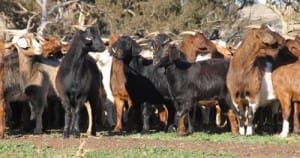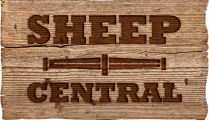
High goat prices are an incentive for a livestock enterprise change.
LIVESTOCK producers struggling to restock with high-priced sheep and cattle should consider integrating some goats into their operations, a new MLA-funded report has shown.
The economic analysis of the benefits of mixed grazing with goats has found they have the potential to complement the financial returns of cattle and sheep when integrated into existing livestock operations across a range of environments.
The analysis was commissioned by Meat & Livestock Australia and undertaken by agribusiness consultants, Agripath, to examine the outcomes of introducing goats into six existing sheep and/or cattle businesses in the pastoral/rangeland and high rainfall/farmland zones of eastern and south eastern Australia. It found that, based on bottom line figures, producers should be considering goats in both environments, particularly where there were rough or unimproved feed sources.
A management package has been developed to assist new entrants to the goat industry and to facilitate a more managed approach to increase production and the continuity of supply and quality of goat meat.
Wool-goat business has benefits
A partial budget analysis of the change from a ewe breeding flock of 500 Merino ewes to 400 Merino ewes plus 160 breeding does is outlined in the Agripath report. It demonstrated that for such an enterprise change there would be:
A 38 percent return on the capital required to make the change
A net gain to the business of $1961 due to savings in sheep husbandry costs and savings in summer weed control.
A low capital requirement of $5220 to replace 100 ewes with 160 does.
The report said at current purchase costs, advantages goats could bring to sheep-goat-cropping business included increased efficacy of weed control on farming country, increased farm stocking rate without more grazing pressure and a lower capital requirement to replace sheep with goats and flexibility in grazing management. The net benefit to a business replacing 120 wool wethers with 600 meat does on the scrub country was estimated at $23,592.
Goat meat price of 600c/kg is an incentive
MLA’s Goat Industry Project manager Julie Petty said with over-the-hook goat indicators still sitting at 600c/kg carcase weight since hitting the new record high in July, there were many incentives for producers to consider introducing managed goat herds, not just opportunistic rangeland harvesting.
“Market price is a key driver in the profitability of the goat enterprises studied in this analysis.
“While producers have very little control over the market price, they can still influence their profitability and productivity by focusing on things within their control such as careful evaluation of their marketing options, ensuring animals supplied consistently meet market specifications, and evaluating their business and land to best match the enterprise type,” Ms Petty said.
“For example goats may be a more profitable stocking choice for some rougher paddocks with woody weed issues.
“Slaughter is not the only option for captured goats. There is currently strong demand for breeding stock, and therefore there are opportunities to sell underweight animals, pregnant nannies and other breeding stock to other producers or retain to further build their own herds,” she said.
“With more intensive management to maintain a high kidding rate and survival, returns are competitive with traditional high performing enterprises such as prime lambs and trading cattle.
“The evidence from the case studies also suggests that these competitive returns can be achieved on lower quality pastures and browse.”
Goat introduction can be profitable
The introduction of goats in five of the six businesses analysed was found to have provided an economic benefit to the landholder. Returns on the extra capital ranged from 16-49pc, indicating the introduction of goats was more profitable than prior enterprise use and land utilisation.
In one case study in the NSW tablelands, goats were used to control weeds as an alternative to chemicals. Previous control of blackberry and nodding thistle infestations in one paddock using a helicopter had cost the landowner $9500.
However, the landowner found the strategic grazing of goats was cutting reliance on herbicides and helicopter spraying and increasing the property’s profitability and carrying capacity.
The analysis also found there are few economic barriers to entry, with the capital cost of breeding does relatively inexpensive when compared to other livestock enterprises.
“While fencing may be perceived to be a barrier, the producers in the case studies all pointed to other improvements as a result of the investment, such as management of grazing pressure, ease of handling and mustering, and exclusion of competing wildlife,” Ms Petty said.
The analysis found that, while there are currently no price premiums in the industry to reflect carcase quality differences, goat producers should focus on maximising returns through management and maximisation of turn-off weights and condition scores to meet market specifications and sending consistent lines of animals for processing.
“The high prices we’re seeing at the moment are being driven in part by strong overseas demand for Australian goatmeat.
“This isn’t an overnight fad either, prices have been steadily increasing for over 18 months now,” Ms Petty said.
“It’s a fantastic time to get into the goat industry and MLA and the Goat Industry of Australia (GICA) are committed to assisting people through the diversification process.
“Many of the levy funded programs, such as this one are designed to help us build up a sustainable supply base.”
Goat management package to build sustainable supply
MLA’s goat management package also consists of an annual management plan template for the high rainfall/farmland and pastoral/rangeland production zones that was developed and tested in conjunction with an advisory panel of goat producers.
Three producer case studies in the package outline how goats have been successfully integrated into existing livestock systems. These highlight the various motivations for going into goats, how goats were integrated into the existing livestock business and how goats have been managed in these businesses.
Nine Fact Sheet resources have also been developed based on topics resulting from suggestions made during a session themed – “If you were to do it all again, what information would you want to know?” as part of the one-day advisory panel workshop.
It is hoped the management plan will help build sustainable supply from the rangelands, increase high-value goat production from agricultural areas, manage supply chains for increased reliability, increase the number and capacity of Australian goat producers and decrease opportunistic goat harvesting.
To read the Agripath economic analysis with management package details, click here.
For more information on Going into Goats click here.
Source: MLA.

HAVE YOUR SAY